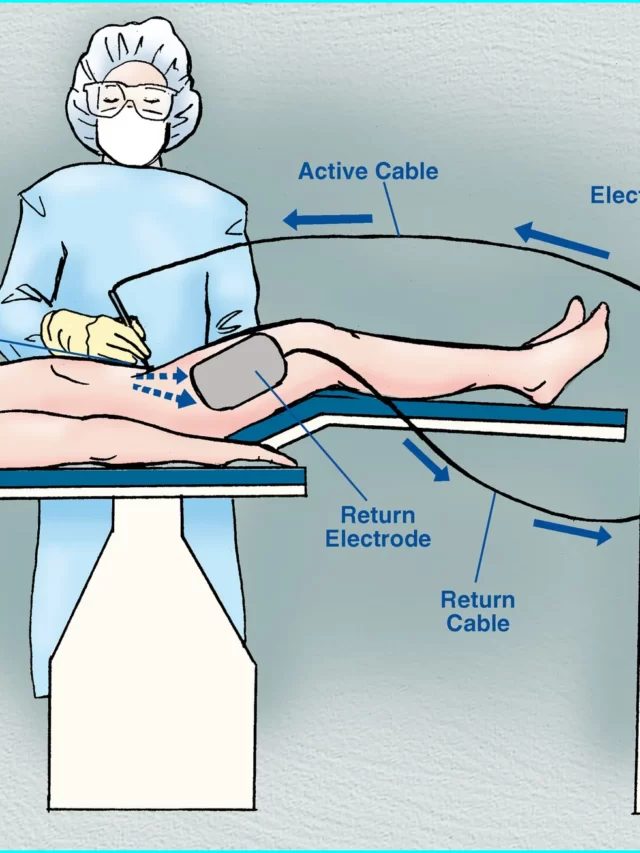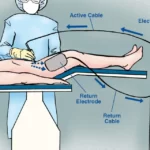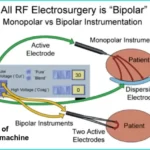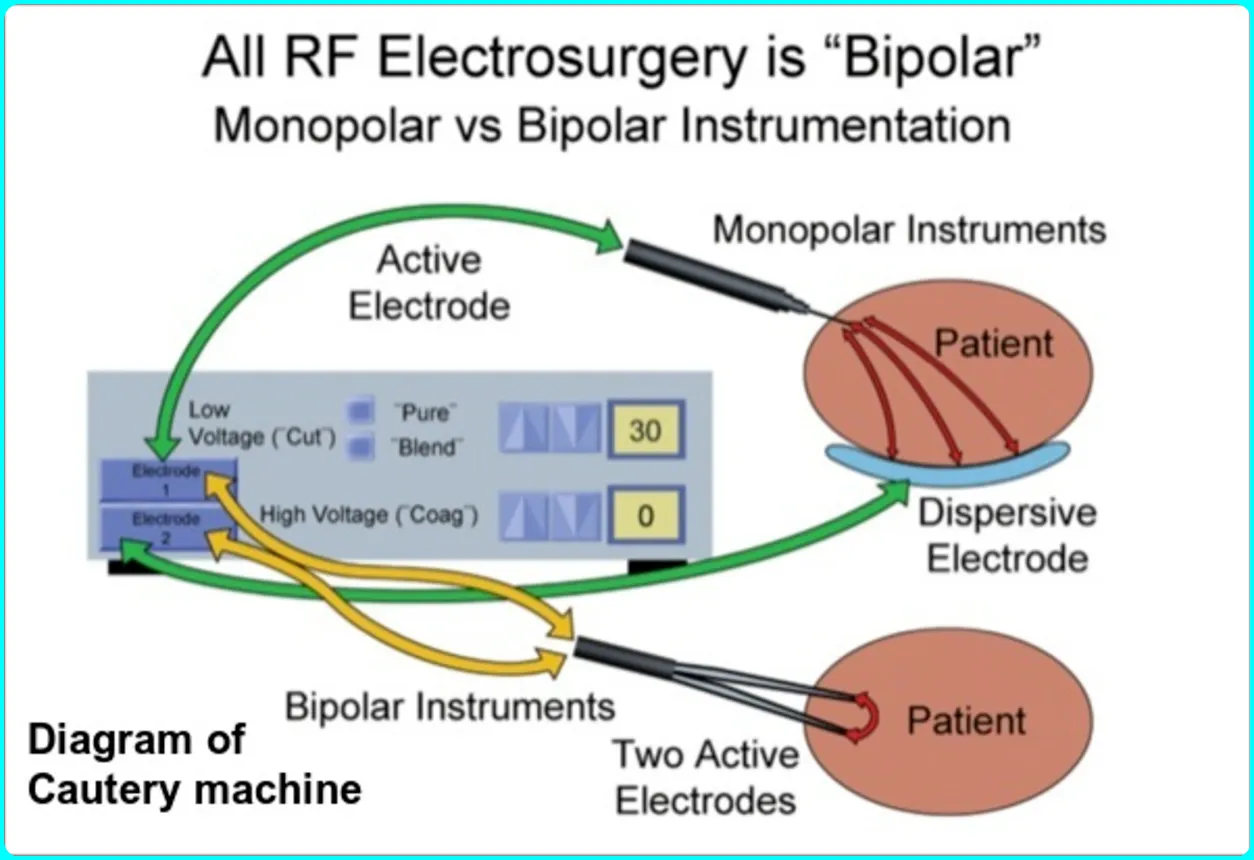What is a cautery machine
Cautery machines are used in ENT, ophthalmic, etc. surgery routinely for a variety of tasks to cut, freeze, dissect, fulgurate, isolate and shrink tissue.
At high frequencies such as 100 kHz to 5 MHz, alternating current at various voltages (200–10,000 volts) is passed through the tissue to generate heat.
It consists of a generator and a handpiece with one or more electrodes in an electrosurgical unit. The device can be controlled using the switch on the handpiece or the foot switch.
They produce different types of electrical waves. As these waves change, so do the associated tissue effects.
What is the working principle of cautery machine
The cautery machine uses high-frequency electrical energy to clot the bleeding or cut tissue. Preferential conduction of electrical energy by blood vessels allows coagulation.
Article About:- Health & fitness
Article About:- Medical Technology
Article About:-Sports
It is important to remove pooled blood and irrigation fluid from the operative area which acts as an insulator or can dissipate the energy of the cautery, which can sometimes reduce its effectiveness.
It consists mainly of electrocautery, also known as thermal cautery, refers to a process in which a direct or alternating current is passed through a fine-resistance metal wire electrode, thereby releasing heat.
is generated. Hot electrodes are then applied to the living tissue to achieve varying degrees of hemostasis or tissue destruction.
Electrocautery can be used in various minor surgical procedures in dermatology, ophthalmology, nose ear larynx, otolaryngology, plastic surgery and urology.
In this process the current does not pass through the patient; Thus, the procedure can be used safely or has no harm in patients with implanted electrical devices such as cardiac pacemakers, implantable cardioverter-defibrillators, and deep-brain stimulators.
How to Work the Cautery Machine
First plug the system power cord into the Energy Platform’s panel receptacle and check for proper grounding.
Connect directly to AC power and try to avoid the maximum power strip or extension cord, let’s say, use it.
Turn on the ESU energy console and verify the self-test automatically. After the self-test is successfully completed. A green light appears on the screen.
Connect the footswitch correctly and check to work by activating after connecting to the machine. According to the machine model, unipolar/dipole footswitches vary.

Connect the neutral plate connector to the machine and check the connectivity then there is a green light on the control panel
Now connect the sterile monopolar or bipolar pencil provided by the scrub. Connect the machine end to the appropriate connection and check the values of the Diathermy Endosurgical Unit are correct.
Surgeons can prioritize the setting of tissues and procedures.
Now check if it is working properly by activating the CUT and COAG buttons on the hand control/footswitch.
Beep sound and flashing light on control panel when activated indicates use of Endo Surgical Unit
Different machines have different modes like cutting and coagulation.
Electrosurgical Cautery Machine
A cautery machine works by utilizing electrical energy to generate heat, which is then used to perform a variety of medical procedures.
- Electrical circuit: The cautery machine is connected to a power source, typically an electrical outlet. The machine contains a circuit that controls the flow of electrical current.
- Electrosurgical generator: Inside the machine, there is an electrosurgical generator that produces the high-frequency electrical current required for cautery. This generator converts the standard alternating current (AC) from the power source into a high-frequency electrical waveform.
- Handpiece and electrode: The electrosurgical generator is connected to a handpiece, which holds the electrode. The electrode is the part that comes into contact with the patient’s tissues.
- Activation: When the cautery machine is activated, the electrical current from the generator is sent through the handpiece and to the electrode. The electrical current flows in a controlled manner through the electrode tip.
- Tissue interaction: As the electrode tip comes into contact with the patient’s tissues, the high-frequency electrical current passes through the tissues. The resistance encountered by the current generates heat through a process called Joule heating.
- Cutting, coagulation, or cauterization: Depending on the mode and settings selected on the cautery machine, the generated heat can be used for different purposes. For cutting, a continuous high-frequency current is used to provide a precise and controlled incision. For coagulation, the current is delivered intermittently to create a coagulum and stop bleeding. Cauterization involves applying the heat for a longer duration to seal off blood vessels or remove unwanted tissues.
- Safety features: Cautery machines often incorporate safety features to minimize the risk of electrical burns or other complications. For instance, they may have mechanisms to monitor tissue impedance and automatically adjust the energy output accordingly.
It’s important to note that cautery machines should be operated by trained medical professionals who are familiar with the equipment and the specific procedures they are performing.
What are the types of electrocautery?
High-frequency electrosurgery can be referred to four different methods:
1.) Electrocoagulation.
2.) electrodesication.
3.)Electrofulguration.
4.) Electrosection.
These methods involve high-frequency alternating current, which is converted into heat by resistance when it passes through the tissue.
What is Bipolar cautery machine
Bipolar electrosurgery Both the active electrode and the return electrode can be used at the site of surgery. It consists of two tips that act as active and return electrodes.

Only the tissue held in forceps is included in the electrical circuit. Since the withdrawal function is performed by one end of the forceps, electrodes are not required to return the patient.
Bipolar cautery operates regardless of the medium in which it is used. This allows for coagulation in a liquid environment, a major advantage when attempting to coagulate in a wet area. As a result, bipolar electrosurgery is often referred to as ‘wet field’ cauterization.
What is the Monopolar cautery machine
Monopolar electrosurgery active electrodes are placed at the surgical site. Patient return electrodes, also called dispersive pads, are placed elsewhere on the patient’s body.
This current passes through the patient as it completes the circuit from the active electrode to the patient return electrode. The function of the return electrode is to safely remove the current from the patient.
If the heat generated over time is not dissipated safely by the shape or conductivity of the patient’s return electrode, a return electrode burn occurs.
Article About:- Health & fitness
Article About:- Medical Technology
Article About:-Sports

What is Advantages or Benefits of the Cautery Machine
1.) The electrodes used in electrosurgery are easy to bend or use which help to lubricate the soft tissues.
2.) Electrodes can be cut at its edge and end which helps to cut soft tissues deeply.
3.) It has much faster cutting speed than other methods like diode laser.
4.) It is a painless method.
5.) If the electrode is cleaned during operation, it can produce consistent, faster and better results.
6.) In this the electrode tips can be changed into pencil shape which can cut narrowly and precisely.
7.) This is a cheaper method.
8.) These electrodes themselves are disinfected.
9.) It is used to help prevent blood loss during surgical operations.
What is Drawbacks or Disadvantages of the Cautery Machine
1.) The smell of burning flesh using electrosurgery is greater than with diode laser technology.
2.) The taste of burnt meat during surgery remains in the mouth for a long time.
3.) It is necessary for the patients to be anesthetized for the surgery.
4.) It is a very fast cutting method, if proper care is not taken by the doctors it can lead to excessive harvesting.
5.) High heat is generated during cutting and hence it is not used near implants. A diode laser is used near the implant.
What is the cost of Cautery machine
The cost of a cautery machine, however, varies according to the make and model. Mainly its price ranges from $ 225 to $ 8500. But its price varies with the city.
Cautery Machine for Dermatology
A cautery machine used in dermatology, often referred to as a dermatologic cautery unit or electrocautery device, is a specialized instrument designed for various skin-related procedures. It operates on the same principles as a general electrosurgical cautery machine, but with specific features tailored for dermatological applications.
- Power source: The dermatologic cautery machine is connected to a power source, which can be an electrical outlet or a battery, providing the necessary electrical energy to power the device.
- Control panel: The machine is equipped with a control panel that includes knobs, buttons, and displays. These controls allow the dermatologist or medical professional to adjust settings such as power output, waveform type, and other parameters based on the specific procedure and patient requirements.
- Handpiece and electrode: The dermatologic cautery machine consists of a handpiece that connects to the main unit. The handpiece holds the electrode, which is the part of the instrument that comes into contact with the patient’s skin.
- Active electrode options: Dermatology cautery machines often offer a range of electrode options to accommodate different procedures and treatment goals. These electrodes may include a fine-tip electrode for precise pinpoint cauterization, a loop electrode for larger tissue areas, a ball electrode for coagulation, or other specialized electrode types.
- Electrical waveform generation: Inside the cautery machine, an electrosurgical generator generates a high-frequency electrical current. This generator converts the power supply’s alternating current (AC) into a high-frequency waveform specifically optimized for dermatological procedures.
- Modes of operation: Dermatology cautery machines typically offer multiple modes of operation, including cutting, coagulation, and desiccation modes. The cutting mode produces a continuous, precise incision, while the coagulation mode enables controlled hemostasis (stopping bleeding) by creating a coagulum. The desiccation mode is used for tissue drying and removal.
- Delivery of electrical energy: When the dermatologist activates the machine and brings the electrode into contact with the targeted skin area, the high-frequency electrical energy is delivered through the electrode. The electrical current flows through the tissues, generating heat through resistance and producing the desired effect.
- Tissue manipulation: The generated heat from the electrical current can be utilized for various dermatological procedures. It can be used for precise cutting, such as the removal of skin lesions or warts. Additionally, it can be employed for coagulation to stop bleeding during procedures or for desiccation to remove or ablate unwanted tissue.
- Safety features: Dermatology cautery machines incorporate safety features to ensure patient safety and prevent potential complications. These features may include impedance monitoring, adjustable power levels, audible and visual alarms, and grounded circuits to minimize the risk of electrical shock.
It’s important to note that dermatologic cautery machines should be used by trained dermatologists or medical professionals who have expertise in dermatological procedures. Proper training and adherence to safety protocols are essential to ensure optimal outcomes and patient safety.

Troubleshooting of Cautery Machine
Caution When troubleshooting the machine, it is important to follow proper safety procedures and consult the manufacturer’s instructions or guidelines specific to your device. However, here are some general troubleshooting steps that you can take if you encounter problems with the caution machine:
- Check power supply: Make sure the machine is properly connected to a power source, and if it runs on batteries, check that the battery is charged or needs to be replaced.
- Verify Connections: Make sure all cables, connectors, and electrodes are securely attached to their respective ports. Loose connections may cause the machine to malfunction or lose power.
- Check the display and controls: Make sure the control panel display is working properly and that there are no error messages or abnormal readings. Verify that the settings on the control panel are appropriate for the intended operation.
- Test different modes: If the machine offers different modes (eg, chopping, coagulation), try switching between them to see if the problem persists. This can help determine if the problem is specific to one mode or affects all functions.
- Inspect the electrodes: Check the electrodes for any damage, corrosion or wear. Replace the electrodes if necessary, as faulty or worn electrodes can affect machine performance.
- Safety features: Verify that all safety features, such as impedance monitoring or alarms, are operating as expected. If a safety mechanism is triggered or is not working properly, contact the manufacturer for assistance.
- Consult the User Manual: Refer to the user manual or documentation provided by the manufacturer for troubleshooting steps specific to your cautery machine model. It can provide detailed instructions and troubleshooting guidelines for common problems.
- Contact the manufacturer or service provider: If the problem persists or you are unsure how to perform any troubleshooting steps, it is recommended to contact the manufacturer’s customer support or a qualified service provider for assistance. They can provide expert guidance and arrange repairs if necessary.
Cautery machines are medical equipment, and it is important to follow proper safety protocols and obtain professional assistance to deal with technical issues in order to operate the machine safely and effectively.
FAQ
How does a cautery machine work

A cautery machine works by utilizing electrical energy to generate heat, which is then used to perform a variety of medical procedures.
Electrical circuit: The cautery machine is connected to a power source, typically an electrical outlet. The machine contains a circuit that controls the flow of electrical current.
Electrosurgical generator. ..
Handpiece and electrode. ..
Activation. ..
Tissue interaction. ..
Safety features. ..
how to use a cautery machine

Using a cautery machine requires proper training and understanding of the specific procedures you intend to perform. It’s important to consult the manufacturer’s instructions or guidelines for your specific cautery machine model, as they may provide detailed instructions tailored to the device.
Preparations:
Ensure that you have received appropriate training on cautery procedures and familiarize yourself with the specific machine you will be using.
Patient Preparation. ..
Machine Setup. ..
Safety Measures. ..
What is a cautery machine used for?

Information. In surgery, electrocauterization (also known as electrocautery) is frequently used to remove undesirable or hazardous tissue. Blood vessels can also be burned and sealed using it. When having surgery or after an injury, this aids in reducing or stopping bleeding.
What are the different types of cautery machines?

Monopolar cautery devices, bipolar cautery devices, and laser cautery devices are some of the several types of cautery devices. Bipolar cautery machines employ two electrodes to apply electrical current to the tissue, as opposed to monopolar cautery machines, which use just one electrode.
What is the process of cautery?

A procedure known as electrocautery, commonly referred to as thermal cautery, involves passing a direct or alternating current through a tough metal wire electrode to produce heat. Once hemostasis or varied degrees of tissue damage have been achieved, the heated electrode is subsequently introduced to living tissue.
What are the 2 types of electrosurgery?

The phrase “electrosurgery” is used to designate a number of techniques that employ electricity to dry up, coagulate, or vaporize tissue in order to destroy it thermally. High-frequency electrosurgery and electrocautery are the two types of electrosurgery that are most frequently employed.
What chemical is used in cautery?

Dermatologic lesions are cauterized with chemical caustic agents (trichloroacetic acid, phenol). Because it necessitates frequent dips and/or efforts, its administration with an earbud, toothpick, or insulin syringe is not safe.





